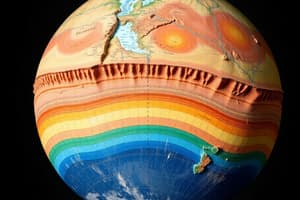Podcast
Questions and Answers
What is the primary driving force behind the movement of tectonic plates?
What is the primary driving force behind the movement of tectonic plates?
- Earth's rotation
- Convection currents in the mantle (correct)
- Gravitational pull of the moon
- Magnetic fields from the core
Which type of plate boundary is characterized by plates sliding past each other?
Which type of plate boundary is characterized by plates sliding past each other?
- Transform boundary (correct)
- Divergent boundary
- Subductive boundary
- Convergent boundary
What geological feature is primarily formed as a result of convergent plate boundaries?
What geological feature is primarily formed as a result of convergent plate boundaries?
- Rift valleys
- Mountain ranges (correct)
- Ocean basins
- Mid-ocean ridges
Which of the following is associated with divergent plate boundaries?
Which of the following is associated with divergent plate boundaries?
What is one significant consequence of tectonic plate movements?
What is one significant consequence of tectonic plate movements?
Which geological feature is formed as a direct result of transform boundaries?
Which geological feature is formed as a direct result of transform boundaries?
When did the theory of plate tectonics gain widespread acceptance?
When did the theory of plate tectonics gain widespread acceptance?
Which layer of the Earth lies beneath the lithosphere and allows for the movement of tectonic plates?
Which layer of the Earth lies beneath the lithosphere and allows for the movement of tectonic plates?
Flashcards are hidden until you start studying
Study Notes
Plate Tectonics Theory
-
Definition: A scientific theory explaining the structure and movement of Earth's lithosphere, which is divided into tectonic plates.
-
Key Components:
- Lithosphere: The rigid outer layer of Earth, consisting of the crust and upper mantle.
- Asthenosphere: A semi-fluid layer beneath the lithosphere that allows for the motion of tectonic plates.
-
Types of Plate Boundaries:
-
Convergent Boundaries:
- Plates move toward each other.
- Can result in subduction (one plate sliding beneath another) or mountain building.
- Example: The Himalayas (India and Eurasian plates).
-
Divergent Boundaries:
- Plates move apart from each other.
- Typically associated with mid-ocean ridges and rift valleys.
- Example: Mid-Atlantic Ridge.
-
Transform Boundaries:
- Plates slide past each other horizontally.
- Often cause earthquakes.
- Example: San Andreas Fault in California.
-
-
Plate Movement:
- Driven by convection currents in the mantle.
- Plates can move at varying rates (typically a few centimeters per year).
-
Impact of Plate Tectonics:
- Earthquakes: Occur mainly at transform and convergent boundaries.
- Volcanism: Associated with convergent and divergent boundaries.
- Mountain Formation: Result from the collision of tectonic plates.
-
Historical Context:
- Developed in the early 20th century, building on Alfred Wegener's theory of continental drift.
- Widely accepted after the discovery of seafloor spreading and paleomagnetism in the 1960s.
-
Current Understanding:
- Active research in areas like plate motion mechanisms and the effect of tectonic activities on climate and ecosystems.
-
Geological Features:
- Earthquakes, volcanoes, mountain ranges, and ocean basins are all results of plate interactions.
-
Significance:
- Understanding plate tectonics is crucial for predicting natural disasters and studying Earth's geological history.
Plate Tectonics Theory
- Definition: Explains the Earth's lithosphere structure and movement, based on tectonic plate dynamics.
- Key Components:
- Lithosphere: Comprises the rigid crust and upper mantle; serves as the outer layer of Earth.
- Asthenosphere: A semi-fluid layer underlying the lithosphere, enabling tectonic plates to move.
Types of Plate Boundaries
- Convergent Boundaries:
- Plates migrate towards each other, leading to either subduction or mountain formation.
- Notable example: Himalayas formed by the collision of the Indian and Eurasian plates.
- Divergent Boundaries:
- Plates separate from one another, commonly associated with mid-ocean ridges and rift valleys.
- Example: Mid-Atlantic Ridge, where new oceanic crust is formed.
- Transform Boundaries:
- Plates slide horizontally past each other, frequently resulting in earthquakes.
- Example: San Andreas Fault in California which is famous for seismic activity.
Plate Movement
- Driven by convection currents within the mantle, facilitating varying rates of plate motion (generally a few centimeters annually).
Impact of Plate Tectonics
- Earthquakes: Primarily occur at transform and convergent boundaries.
- Volcanism: Linked with convergent and divergent boundaries, leading to volcanic eruptions.
- Mountain Formation: Arises from the collision of tectonic plates, creating vast mountain ranges.
Historical Context
- Originated in the early 20th century, evolving from Alfred Wegener's continental drift theory.
- Gained acceptance post-1960s through discoveries in seafloor spreading and paleomagnetism.
Current Understanding
- Ongoing research focuses on mechanisms driving plate movements and their influence on climate and ecosystems.
Geological Features
- Various geological formations, such as earthquakes, volcanoes, mountain ranges, and ocean basins, stem from the interactions of tectonic plates.
Significance
- Grasping plate tectonics is essential for predicting natural disasters and unraveling Earth's geological history.
Studying That Suits You
Use AI to generate personalized quizzes and flashcards to suit your learning preferences.




